travel
Teaching Of The Buddhas
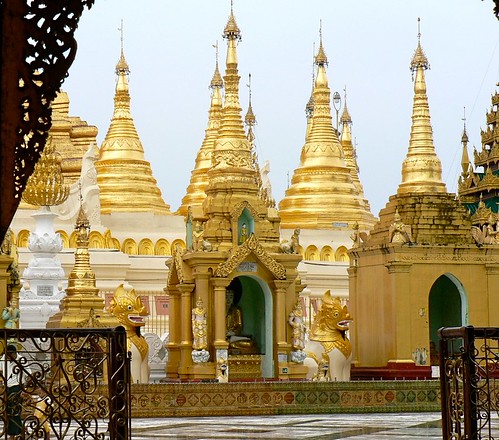 On my recent journey in Burma, I was kidnapped on my final day in Yangon. Wait a minute. Don't be alarmed. Not really kidnapped. Borrowed, let's say. It went something like this, it was my final day and I was planning on visiting the most famous pagoda in Yangon, Shwedagon Pagoda, a pilgrimage site for the Burmese people.
On my recent journey in Burma, I was kidnapped on my final day in Yangon. Wait a minute. Don't be alarmed. Not really kidnapped. Borrowed, let's say. It went something like this, it was my final day and I was planning on visiting the most famous pagoda in Yangon, Shwedagon Pagoda, a pilgrimage site for the Burmese people.
A small history of the Shwedagon Pagoda:
According to legend, the Shwedagon Pagoda is 2500 years old. Archaeologists believe the stupa was actually built sometime between the 6th and 10th centuries by the Mon, but this is a very controversial issue because according to the records by Buddhist monks it was built before Lord Buddha died in 486 BC. The story of Shwedagon Pagoda begins with two merchant brothers, Taphussa and Bhallika, from the land of Ramanya, meeting the Lord Gautama Buddha and receiving eight of the Buddha's hairs to be enshrined in Burma. The two brothers made their way to Burma and with the help of the local king, King Okkalapa, found Singuttara Hill, where relics of other Buddhas preceding Gautama Buddha had been enshrined. When the hairs were taken from their golden casket to be enshrined some incredible things happened:
“There was a tumult among men and spirits ... rays emitted by the Hairs penetrated up to the heavens above and down to hell ... the blind beheld objects ... the deaf heard sounds ... the dumb spoke distinctly ... the earth quaked ... the winds of the ocean blew ... Mount Meru shook ... lightning flashed ... gems rained down until they were knee deep ... all trees of the Himalayas, though not in season, bore blossoms and fruit.”
The stupa fell into disrepair until the 1300s when the Mon king Binnya U of Bago had the stupa rebuilt to a height of 18 meters (60 ft). It was rebuilt several times and reached its current height of 98 meters (320 ft) in the 15th century. The Mon kingdom possessed two great pagodas of especial sanctity, the Shwemawdaw at Bago and the Shwedagon. Originally only twenty-seven feet high, it was raised to a height of sixty-six feet in 1362 by King Binnya U as an act of special piety. Dhammazedi's immediate predecessor, his mother-in-law Queen Shinsawbu (1453-72), raised its height to 40 meters (129 ft). She terraced the hill on which it stands, paved the top terrace with flagstones, and assigned land and hereditary slaves for its maintenance. When in 1472 she yielded up the throne to Dhammazedi, she retired to Dagon, and during her last illness had her bed placed so that she could rest her dying eyes upon the gilded dome of the sacred fane. The Mon face of the Shwe Dagon inscription catalogues a list of repairs beginning in 1436 and finishing during Dhammazedi's reign. It mentions Queen Shinsawbu under a terrific Pali name of sixty-six letters. By the beginning of the sixteenth century the pagoda had become the most famous place of pilgrimage in Burma.
But it was also my last day so I was thinking I would "pagoda-hop" to another famous shrine with a reclining buddha an then hit the markets, most notably Bogyoke Aung San Market, the largest in Yangon. I had spent a day in Yangon at the beginning of my trip, but knowing that Burma is a country where you have to have all the money you will need on your person - no ATMs, no credit cards accepted - I was wary of buying gifts or souvenirs on the first day since I didn't know how much money I would need and was definitely on a tight budget. I therefore arranged my final day in Yangon to be able to let loose and spend any extra money I had in the market.
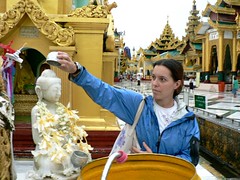 I arrived in Shwedagon Pagoda and it was lightly raining. It's rainy season throughout SE Asia, I'd gotten used to the rain by now. Like all pagodas in Asia you must remove your shoes at entrance meaning you then climb the stairs and have to walk around the entire exterior and interior without shoes. Which is normally fine, but on the marble floor at Shwedagon I kept feeling like my feet were falling out from under me. I sat under one part of the plaza and allowed myself just to watch people walk by. Seeing people of all ages there making pilgrimages was really amazing. They knew the prayers, which spots in this enormous place where the most famous. I was without a specific tourbook and mostly content to just walk around and take it all in.
I arrived in Shwedagon Pagoda and it was lightly raining. It's rainy season throughout SE Asia, I'd gotten used to the rain by now. Like all pagodas in Asia you must remove your shoes at entrance meaning you then climb the stairs and have to walk around the entire exterior and interior without shoes. Which is normally fine, but on the marble floor at Shwedagon I kept feeling like my feet were falling out from under me. I sat under one part of the plaza and allowed myself just to watch people walk by. Seeing people of all ages there making pilgrimages was really amazing. They knew the prayers, which spots in this enormous place where the most famous. I was without a specific tourbook and mostly content to just walk around and take it all in.
Two monks approached me. One with bitteroot red lips and teeth smiling at me, the other more quiet with cleaner looks. Where am I from. How long am I in Burma. The usual questions. Their English was fair, my patience was at an all-time high and I'd gotten very good at knowing what words tended to be known by people with limited English and could speak very slow so that they understood. They were nice, kind, eager to engage and practice their English. A few minutes passed and I stood from my perch where I had been quietly and meditatively watching the crowds before the monks arrived. It was time to go on my way. "It was nice talking to you, thank you, enjoy your day." I said and walked away.
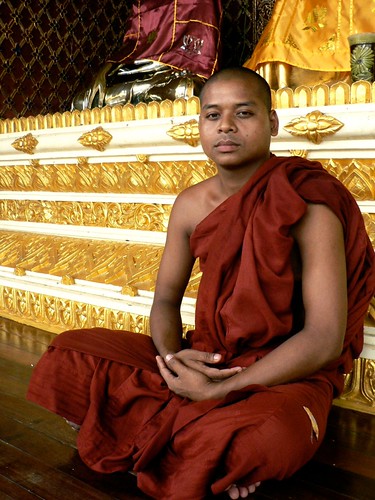 Footsteps behind me. "Would you like us to show you around?" They said.
Footsteps behind me. "Would you like us to show you around?" They said.
Sure, why not, I thought. So we walked. They were fast on the slippery marble ground, I took small footsteps close together but very fast more like a shuffle than a walk. They showed me where the 8 hairs of Buddha are kept (supposedly), where you pray based on the day of the week on which you are born, how to bang the bells that hang everywhere and the purpose. It started to pour rain, "Let's meditate" they said. And we walked into one shrine and sat and I closed my eyes and kept them closed until my breathe had calmed and my mind was clear. Maybe 10 minutes. I opened my eyes but didn't move an inch. I looked out of the corner of my eye and their eyes were closed and then just like that, they opened and looked at me. Calm. Peaceful. "Let's move on."
"Well I was going to go to another pagoda and uhm, see from there." "We can take you there." They said. "Ok, sure." I said.
Because sometimes when you travel, you have to give into the experience. I guess life is like that too. You think you have an idea of how a day is going to go, a relationship, a job, and then it turns. It changes. What I've realized is it's ok to keep the path, if that's what you want, but it's also ok to deter from your plan and take life as it comes.
On this day in Burma, two monks walked we me out of Shwedagon Pagoda and we hopped a cab to Chaukhtatgyi Temple and visited the Reclining Buddha there. We circled the Buddha and they exited a back gate and started climbing a hill (barefoot of course). I'm to follow? Ok. We walk and pass monks and I ask my new friends all the questions I've ever had about monks, about their calling and I'm soaking it all in. I've given up now on the market. The daylight hours are waning and the market closes at 5pm. It's ok. I've let go of my expectations for the day.
 We enter a small house. I look around and realize it's a monastery. Now they might have told me we were coming here, I'm not quite sure. They've said much I didn't understand either because of the language barrier or because they spoke so softly. But here we were. They lead me through a room of 100+ monks sitting around each other and to their head teacher. A large man sitting on a chair higher than the rest. I greet him by nodding my head. I'm introduced and we all talk for awhile. I take my picture with him. My friends, the endearing and truly wonderful young monks, and I move on.
We enter a small house. I look around and realize it's a monastery. Now they might have told me we were coming here, I'm not quite sure. They've said much I didn't understand either because of the language barrier or because they spoke so softly. But here we were. They lead me through a room of 100+ monks sitting around each other and to their head teacher. A large man sitting on a chair higher than the rest. I greet him by nodding my head. I'm introduced and we all talk for awhile. I take my picture with him. My friends, the endearing and truly wonderful young monks, and I move on.
The day continues. And these two monks continue to share their "Yangon" with me. Twilight comes and they must return to Shwedagon for evening prayer. We says goodbyes, but not even a handshake. Just nods. And go our separate ways.
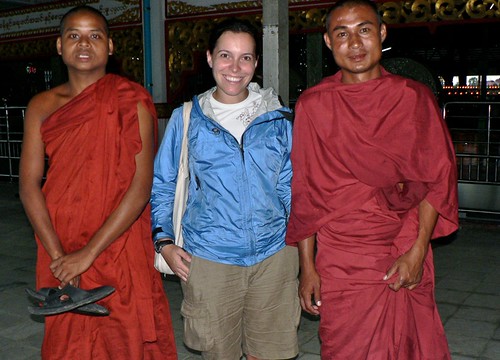
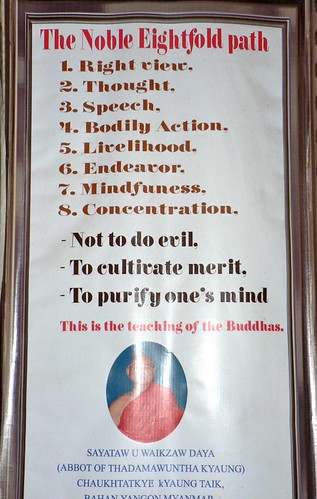 Inside the monastery there had been a sign with the teachings of Buddha that read:
Inside the monastery there had been a sign with the teachings of Buddha that read:
The Noble Eightfold Path
Right view.
View.
Speech.
Bodily Action.
Livelihood.
Endeavor.
Mindfulness.
Concentration.
Not to do evil.
To cultivate merit.
To purify one's mind.
This is the teaching of the Buddhas.
The monks I spent my final day with in Yangon lived these principles. They exemplified this to me. I have thought of them often since leaving Burma mixed in with the memories of the three months abroad. I haven't absorbed entirely my experience and my trip, but the first step is telling some of my stories and allowing myself to remember and feel what it was like there. So I'm hoping that at least for today, I've made a small step forward.
